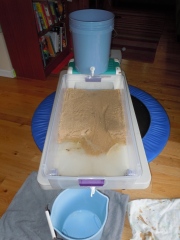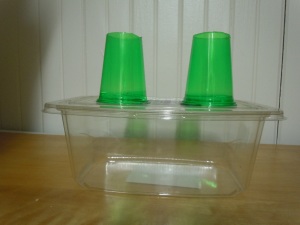This is our Earth Science year. I’ve never formally studied Earth Science (the honors sequence in my high school bypassed it in favor of two years of biology), although my older son was intensely interested in astronomy, meteorology, and natural disasters throughout his younger years. My younger son had no such previous interest, so this year we set to filling that hole in his education. He and I are using CPO Middle School Earth Science and, five chapters in, enjoying the tour of our planet. (We had Chemistry to finish for the first two months. Some day I will finish my science and history plans in a school year.)
CPO Science offers secular courses in Earth, Physical, and Life sciences at the middle school level and physical science (with or without some earth science) at the high school level. We’re using the Middle School Earth Science text and teacher’s manual, both also available on Amazon, Ebay, and a host of used book distributors. While there is an Investigations guide available, it’s not necessary, since the teacher’s guide comes with a few investigations per chapter and the website contains free files of the student portion of those investigations (labeled student record sheets on the website). I purchased the two hardcover books for about $60 after a fair amount of searching.
My initial reaction to the text-book was that it looked a bit childish, with a larger font and more white space than I expected at this level. A closer look proved me wrong — the content is strong and the layout aids learning. CPO science books are bound in landscape format: think picture book style — width greater than height. This allows any sidebars, images, or definitions to fit on the same page as the material covered in the text. The layout of the text strongly supports the reader, with each section broken into smaller parts that span one or two pages and never require turning a page to finish. From a practical standpoint, this allows the reader to focus on the topic on the page without further distraction. The images on the page, any vocabulary (in the right margin in a blue box), charts, etc., all support that topic. The right hand margin lists the main topic of each paragraph on the page, again supporting the reader and easing the reader when searching back through the chapter after reading it. Parents of ADHD kids, rejoice. This set-up greatly aids the easily distracted reader (got two of those).
Each of the nineteen chapters consists of two to four subsections, each followed by a section review with concept, critical thinking, and mathematical questions. My son and I do these aloud, as they provide a time to discuss the material and make connections. Some require paper and pencil for math calculations. We’ve found a few that don’t have an answer within the chapter and a few where the Teacher’s Guide contains the wrong answer, although the latter has not occurred at a higher rate than any other materials we’ve used. Following the last section is a two-page spread that extends an idea in the chapter, sometimes connecting to another science, and a few more questions to discuss. A chapter activity, different from the investigations, allows another opportunity for hand-on practice of the material. Each chapter ends with an assessment, including questions on vocabulary (fill in the blank), concept questions, a section on math and writing skills, and a chapter project. For now, we’re doing most of that section aloud and ignoring the research project. I’d like to move some of that work to written assignments, but that’s yet to happen.
The teacher’s guide is not an annotated text. It supplies the answers to all the questions, instructions for the investigations, extensions, and additional information. Most chapters start with a demonstration or investigation, designed to be completed before the chapter is read. We’ve done some of these and omitted the ones where set-up outweighs learning benefit or where my son clearly already understands the point being made. The investigation later in the chapter ties together the portions of the learned material. Both have a measure of inquiry built in, with learners thinking through plans and results throughout the investigation. Students to discover information as they go. These inquiries and investigations make up a large amount of the value of the CPO series, and while we’ve left out some, most are on our schedule to complete. CPO sells a supply kit for a rather exorbitant price, but we’ve chosen to piece together our own materials. Notable necessary and potentially pricey items are a stream table and a Geobox. We’ve made our own of both, as illustrated at the end of this post. Overall, the labs are quite manageable, large amounts of wet sand aside. (Our table is way too big to be practical. Wet sand is very heavy. Very heavy. For a more manageable at-home stream table, visit Now is the Best Time.)
The CPO website holds more than just the printable files for the investigations. For each chapter, CPO supplies printable graphic organizers (very basic) for key concepts of the chapter. These have served as a bridge to note taking for my ten-year old, who really doesn’t want to ever use a pencil. After filling out the chart for the layers of the atmosphere, he admitted he learned quite a bit completing the work. That’s a major victory for all in this house. Also available for free printing are skills and practice sheets. These are not regurgitate the fact worksheets or word searches. For example, in the second section of the book, the sheets include internet research techniques and evaluation of sources, dimensional analysis, line graphing practice, a groundwater modeling project, biographies on two scientists (with research questions), an introduction to graphing with spreadsheets, and more. We don’t manage all those pages, but there’s plenty from which to choose, and the materials are high quality extensions to the text.
So a fourth of the way through the book, we’re hooked. With easy-to-read text, a teacher’s manual that adds greatly to the text, and plenty of free, online supports, CPO Middle School Earth Science is a favorite of my son and I. I do supplement with Discovery Streaming and BrainPop videos and some of the readings suggested in the text (each chapter lists supplements on three reading levels). Pair that with outside videos and curiosity-led web searches and we have a fine Earth Science year in progress.

Our totally too-big stream table. The spigots are from a brewery, with one attached to the top bucket and another at the foot of the table, available for draining the table.
Disclosure: I’ve received no compensation in money or materials for this review.


Love your ingenious inventions for Geobox and stream table. Looks like a good resource – will add it to our list.
Cheers, Tracey
Hmm. I found mine used online. A search of the ISBN might help, or just search the title. I just sold mine last week, unfortunately, or I’d offer you that one.
I’ve looked into the CPO Science, but they’re telling me I can’t purchase the Teacher’s Edition without purchasing the kit. I’m waiting on a call from the local rep to see if he can help. Do you mind sharing how you got yours?
Hi! You posted this a long time ago, but could you remember whether this text could be well adapted as an early HS biology course? Maybe by beefing up the labs, writing lab journals, etc? I’d love to get your opinion. Thanks!
Well, it’s Earth Science, a study of geology, meteorology, etc., so no. The same publisher does have a biology course, but I’ve not looked at that. I have a Biology course on this site. See the link at the top of the page
Do you have a list of all the supplies needed for the labs?
No, I don’t.